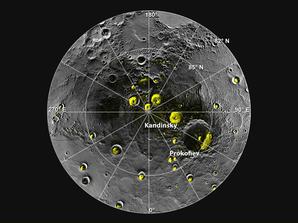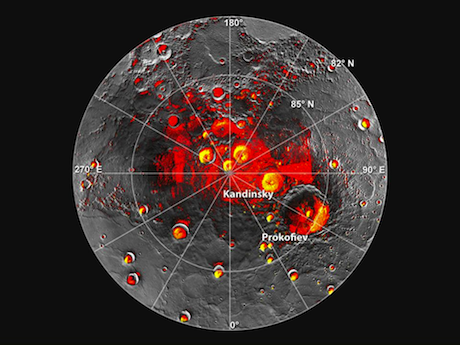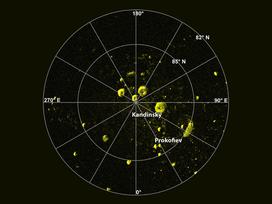
Mercury's North Polar Region Acquired By The Arecibo Observatory
Observations by the MESSENGER craft has provided compelling support for the
hypothesis that Mercury harbors abundant water ice and frozen volatile and
organic materials in its shadowed polar craters.
hypothesis that Mercury harbors abundant water ice and frozen volatile and
organic materials in its shadowed polar craters.
How could there be ice and organics on Mercury you ask? Its thought that
icy comets bombarded the early rocky planets bring ice and organic material. The
deep craters keep it cool enough to keep the ice frozen. There's even the
possibility of liquid water existing.
Given its proximity to the Sun, Mercury seems an unlikely place to find ice.
Due to the nearly zero tilt in its rotational axis, less than one degree,
there are areas on Mercury that receive no sunlight. Its been suggested
decades ago that water ice and frozen volatiles trapped at the
poles.
If Mercury has been in this position since its
creation, it is possible the ice could date back to the origin of the solar
system.
icy comets bombarded the early rocky planets bring ice and organic material. The
deep craters keep it cool enough to keep the ice frozen. There's even the
possibility of liquid water existing.
Given its proximity to the Sun, Mercury seems an unlikely place to find ice.
Due to the nearly zero tilt in its rotational axis, less than one degree,
there are areas on Mercury that receive no sunlight. Its been suggested
decades ago that water ice and frozen volatiles trapped at the
poles.
If Mercury has been in this position since its
creation, it is possible the ice could date back to the origin of the solar
system.
| In 1991 the Arecibo radio telescope in Puerto Rico detected some unusually radar bright patches at the poles reflecting radio waves in the way water ice would. Many of these patches correspond to the locations of large impact craters mapped by Mariner 10 in the 1970's. Planetary scientist lacked a complete diagram of the poles due to Mariner only being able to view 50 percent of the planet. |
Organic Chemicals should not be confused with biological. Organic chemicals
are made from carbon bonded to hydrogen, they are essential to life but are not
necessarily the evidence of life.
The organics on Mercury is suspected to be tar or coal like substances.
Newest data from MESSENGER strongly
indicate that water ice is the major
constituent of Mercury's north pole
deposits. Ice exposed at the surface of the
deposits stay frozen while ice
that is buried beneath an unusual dark material
stay warm enough to form
water.
MESSENGER uses neutron spectroscopy
to measure hydrogen concentrations within
the planets radar-bright regions.
Water-ice concentrations are derived from the
hydrogen measurements.
are made from carbon bonded to hydrogen, they are essential to life but are not
necessarily the evidence of life.
The organics on Mercury is suspected to be tar or coal like substances.
Newest data from MESSENGER strongly
indicate that water ice is the major
constituent of Mercury's north pole
deposits. Ice exposed at the surface of the
deposits stay frozen while ice
that is buried beneath an unusual dark material
stay warm enough to form
water.
MESSENGER uses neutron spectroscopy
to measure hydrogen concentrations within
the planets radar-bright regions.
Water-ice concentrations are derived from the
hydrogen measurements.
"The neutron data indicate that Mercury's
radar-bright polar deposits contain, on average, a hydrogen-rich layer more
than tens of centimeters thick beneath a surficial layer 10 to 20
centimeters thick that is less rich in
hydrogen," writes David Lawrence, a
MESSENGER Participating Scientist based at
The Johns Hopkins University
Applied Physics Laboratory "The buried layer has a
hydrogen content consistent with nearly pure water ice."
Data from MESSENGER's Mercury Laser Altimeter (MLA) corroborate the radar
results. In a second paper, Neumann and his colleagues report that the first MLA
measurements of the shadowed north polar regions reveal irregular dark and
bright deposits at near-infrared wavelength near Mercury's north pole.
"These reflectance anomalies are concentrated on poleward-facing slopes and
are spatially collocated with areas of high radar backscatter postulated to be
the result of near-surface water ice," Neumann writes. "Correlation of observed
reflectance with modeled temperatures indicates that the optically bright
regions are consistent with surface water ice."
The MLA also recorded dark patches with diminished reflectance, consistent
with the theory that the ice in those areas is covered by a thermally insulating
layer. Neumann suggests that impacts of comets or volatile-rich asteroids could
have provided both the dark and bright deposits, a finding corroborated in a
third paper led by David Paige of the University of California, Los Angeles.
Paige and his fellow colleagues provided the first detailed models of the
surface and near-surface temperatures of Mercury's north polar regions.They
utilized the topography of Mercury's surface measured by the MLA. These
measurements show that the spatial distribution of regions of high radar
backscatter is the saem as the predicted distribution of thermally stable
water ice.
Paige suggest that the dark material is likely a mix of organic compounds
delivered to Mercury by the impacts of comets and volatile-rich asteroids. Its
possible the organic material may have been darkened further from the exposure
to the radiation at Mercury's surface, even in the permanently shadowed areas.
This dark insulating material is a new wrinkle to the story according to Sean
Solomon of the Columbia University's Lamont-Doherty Earth Observatory. For over 20 years the jury has been deliberating on whether Mercury hosts abundant water ice in its shadowed polar regions. MESSENGER has now supplied a unanimous
affirmative verdict."
"But the new observations have also raised new questions," adds Solomon. "Do
the dark materials in the polar deposits consist mostly of organic compounds?
What kind of chemical reactions has that material experienced? Are there any
regions on or within Mercury that might have both liquid water and organic
compounds? Only with the continued exploration of Mercury can we hope to make
progress on these new questions."
results. In a second paper, Neumann and his colleagues report that the first MLA
measurements of the shadowed north polar regions reveal irregular dark and
bright deposits at near-infrared wavelength near Mercury's north pole.
"These reflectance anomalies are concentrated on poleward-facing slopes and
are spatially collocated with areas of high radar backscatter postulated to be
the result of near-surface water ice," Neumann writes. "Correlation of observed
reflectance with modeled temperatures indicates that the optically bright
regions are consistent with surface water ice."
The MLA also recorded dark patches with diminished reflectance, consistent
with the theory that the ice in those areas is covered by a thermally insulating
layer. Neumann suggests that impacts of comets or volatile-rich asteroids could
have provided both the dark and bright deposits, a finding corroborated in a
third paper led by David Paige of the University of California, Los Angeles.
Paige and his fellow colleagues provided the first detailed models of the
surface and near-surface temperatures of Mercury's north polar regions.They
utilized the topography of Mercury's surface measured by the MLA. These
measurements show that the spatial distribution of regions of high radar
backscatter is the saem as the predicted distribution of thermally stable
water ice.
Paige suggest that the dark material is likely a mix of organic compounds
delivered to Mercury by the impacts of comets and volatile-rich asteroids. Its
possible the organic material may have been darkened further from the exposure
to the radiation at Mercury's surface, even in the permanently shadowed areas.
This dark insulating material is a new wrinkle to the story according to Sean
Solomon of the Columbia University's Lamont-Doherty Earth Observatory. For over 20 years the jury has been deliberating on whether Mercury hosts abundant water ice in its shadowed polar regions. MESSENGER has now supplied a unanimous
affirmative verdict."
"But the new observations have also raised new questions," adds Solomon. "Do
the dark materials in the polar deposits consist mostly of organic compounds?
What kind of chemical reactions has that material experienced? Are there any
regions on or within Mercury that might have both liquid water and organic
compounds? Only with the continued exploration of Mercury can we hope to make
progress on these new questions."


 RSS Feed
RSS Feed